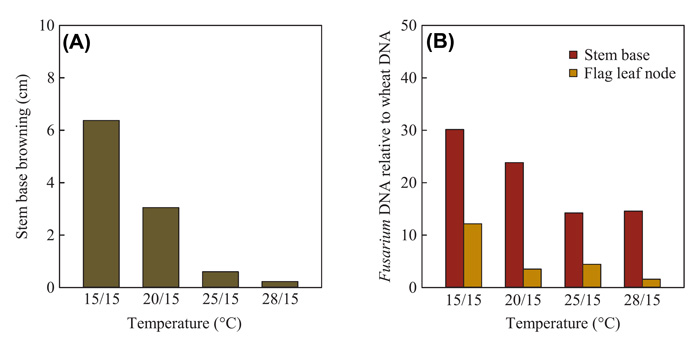| Tweet | Follow @co2science |
Paper Reviewed
Sabburg, R., Obanor, F., Aitken, E. and Chakraborty, S. 2015. Changing fitness of a necrotrophic plant pathogen under increasing temperature. Global Change Biology 21: 3126-3137.
Plant pathogens have long been a thorn in the side of the agricultural industry, reducing crop production between 10-16 percent annually and costing an estimated $220 billion in economic losses (Chakraborty and Newton, 2011). What is more, there are concerns that such damages may increase in the future if temperatures rise as predicted by global climate models in response to CO2-induced global warming. Noting these concerns, Sabburg et al. (2015) write that "to assess potential disease risks and improve our knowledge of pathogen strengths, flexibility, weakness and vulnerability under climate change, a better understanding of how pathogen fitness will be influenced is paramount."
In an attempt to obtain that knowledge, the team of four Australian researchers set out to investigate the impact of rising temperatures on Fusarium pseudograminearum, the "predominant pathogen causing crown rot of wheat in Australia" that is responsible for inducing an average of AU$79 million in crop losses each year. More specifically, they examined "whether the pathogenic fitness, defined as a measure of survival and reproductive success of F. pseudograminearum causing crown rot in wheat, is influenced by temperature under experimental conditions."
The experiment was conducted in controlled-environment glasshouses at the Queensland Crop Development Facility in Queensland, Australia, where eleven lines of wheat were grown under four day/night temperature treatments (15/15°C, 20/15°, 25/15° and 28/15°C for 14-hour days and 10-hour nights). The first three treatments were representative of "the range of average maximum temperatures of the various wheat-growing regions across Australia," whereas the fourth (28/15°C) treatment was intended to simulate a future warming scenario. The minimum temperatures of all treatments were kept at 15°C because "night-time temperatures over the last 50 years in the large majority of wheat-growing regions across Australia have not shown an increasing temperature trend in all seasons." With respect to the eleven wheat lines, they were selected based on known susceptibilities and resistances to crown rot. Fourteen days after sowing a portion of each line was infected with F. pseudograminearum and then grown to maturity.
So what did the researchers find?
With respect to disease severity, Sabburg et al. report it was highest under the lowest temperature treatment and declined with increasing temperature (Figure 1a), and this general reduction was noted in all of the eleven wheat lines. Similarly, pathogen biomass was also reduced as treatment temperature increased (Figure 1b). According to the researchers, "on average, warming reduced pathogen biomass in stem base (PB-S) by 52% at either 25/15°C or 28/15°C compared with the biomass at 15/15°C." And it also decreased the amount of relative pathogen biomass from the stem base to flag leaf node.
A third fitness measure of F. pseudograminearum -- deoxynivalenol content (DON) -- was also reduced in the stem base and flag leaf node tissue as temperature treatment increased. And the significance of this finding was noted by the authors as "an encouraging result if we consider temperature rises in the future," because "DON can make food sources including wheat grains unsafe for human or animal consumption."

Figure 1. Effect of temperature on (Panel A) disease severity as expressed by the length of stem base browning (cm) and (Panel B) relative pathogen biomass in stem base (PB-S) and flag leaf node tissue (PB-F) as measured by Fusarium DNA relative to wheat DNA. All measurements in wheat plants were made at maturity following stem base inoculation by Fusarium pseudograminearum. Adapted from Sabburg et al. (2015).
In light of the above results, Sabburg et al. conclude that "this study has clearly established that temperature influences the overall fitness of F. pseudograminearum," and that "based on our findings, warmer temperatures associated with climate change may reduce overall pathogenic fitness of F. pseudograminearum." And given the annual production and monetary damages inflicted by this pathogen on wheat, this is news worth both reporting and celebrating!
Reference
Chakraborty, S. and Newton, A.C. 2011. Climate change, plant diseases and food security: an overview. Plant Pathology 60: 2-14.




